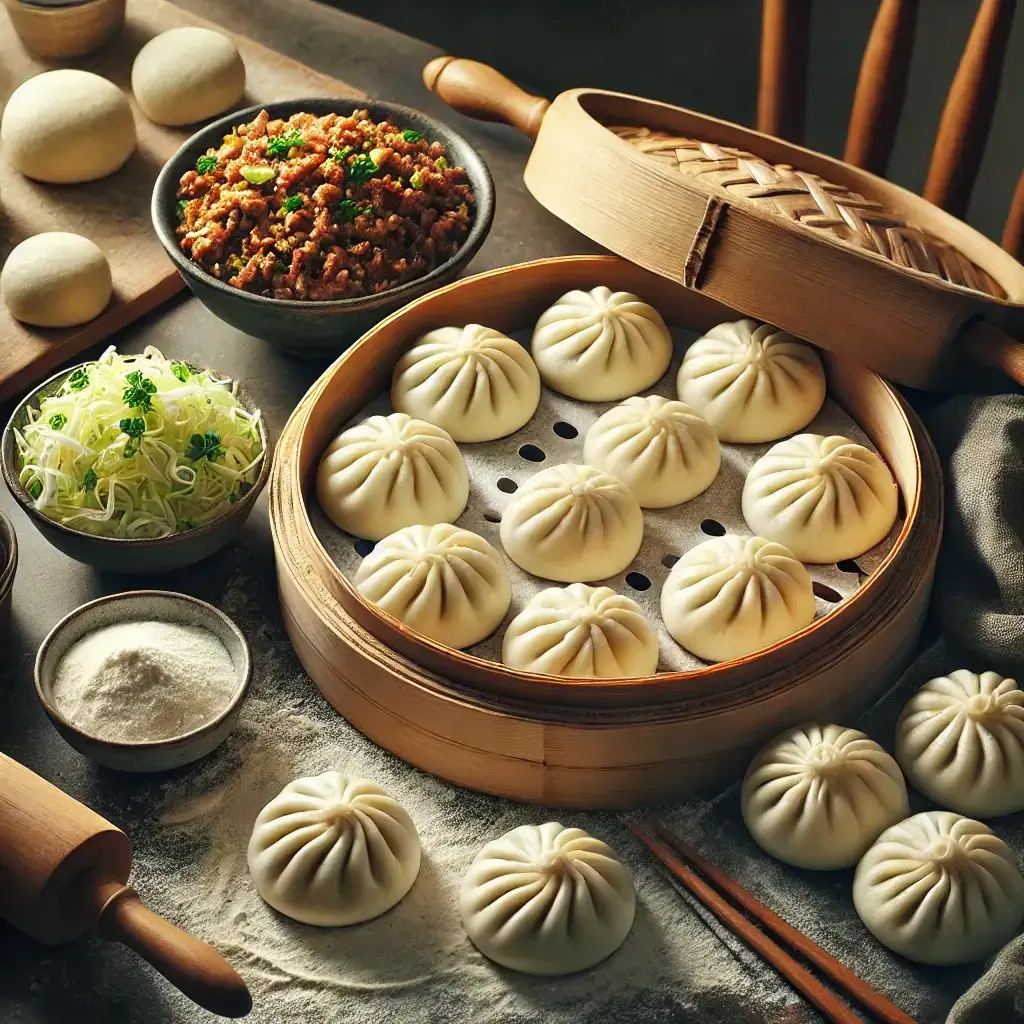
Table of Contents
Chinese baozi, or steamed buns, are a beloved part of Chinese cuisine, often enjoyed as a snack, breakfast item, or part of a larger meal. These buns are typically filled with a variety of savory or sweet fillings, then steamed to create a soft, fluffy texture. Making baozi from scratch is a rewarding process that involves preparing the dough, making the filling, assembling the buns, and steaming them to perfection. This guide will walk you through the steps to create delicious baozi at home.
Ingredients
For the Dough:
- 500g all-purpose flour
- 250ml warm water
- 1 tablespoon sugar
- 1 teaspoon active dry yeast
- 1 teaspoon baking powder
- A pinch of salt
- 1 tablespoon vegetable oil
For the Filling (Pork and Vegetable Example):
- 250g ground pork
- 1 cup Napa cabbage, finely chopped
- 1 tablespoon soy sauce
- 1 tablespoon oyster sauce
- 1 teaspoon sesame oil
- 1 tablespoon minced ginger
- 2 cloves garlic, minced
- 1 tablespoon cooking wine
- 1 teaspoon cornstarch
- Salt and pepper to taste
- 2 stalks green onion, finely chopped
Step 1: Preparing the Dough
1.1 Activate the Yeast:
Begin by activating the yeast, a crucial step for creating the soft, fluffy texture of baozi. In a small bowl, mix the warm water with the sugar and yeast. Allow this mixture to sit for about 5-10 minutes until it becomes frothy, indicating that the yeast is active.
1.2 Mix the Dry Ingredients:
In a large mixing bowl, combine the flour, baking powder, and salt. Create a well in the center of the dry ingredients, and gradually pour in the yeast mixture and vegetable oil. Stir the mixture with a wooden spoon or chopsticks until a rough dough forms.
1.3 Kneading the Dough:
Transfer the dough to a floured surface and knead it for about 10 minutes. The goal is to develop the gluten in the dough, which gives the buns their characteristic chewiness. The dough should be smooth and elastic, not sticky. If it feels too dry, add a little more water; if it’s too sticky, incorporate a bit more flour.
1.4 First Rise:
Place the dough in a lightly oiled bowl, covering it with a damp cloth or plastic wrap. Allow it to rise in a warm place for 1-2 hours, or until it has doubled in size. This first rise is crucial for creating the airy texture of the buns.
Step 2: Preparing the Filling
2.1 Prepare the Vegetables:
While the dough is rising, prepare the filling. Finely chop the Napa cabbage and sprinkle it with a pinch of salt. Let it sit for about 10 minutes, which will help to draw out excess moisture. After 10 minutes, squeeze the cabbage to remove the water, ensuring that your filling isn’t too watery.
2.2 Combine the Ingredients:
In a large bowl, combine the ground pork, drained cabbage, soy sauce, oyster sauce, sesame oil, minced ginger, garlic, cooking wine, cornstarch, and green onions. Mix the ingredients thoroughly until they are well-combined. The cornstarch helps to bind the ingredients together, giving the filling a cohesive texture. Season with salt and pepper to taste.
2.3 Marinate the Filling:
Allow the filling to marinate for about 20 minutes. This step helps to develop the flavors, making the filling more aromatic and flavorful when steamed.
Step 3: Assembling the Baozi
3.1 Punch Down the Dough:
After the dough has completed its first rise, punch it down to release the trapped air. This step ensures that the buns will be evenly textured. Transfer the dough to a floured surface and knead it briefly to remove any air bubbles.
3.2 Divide the Dough:
Divide the dough into equal portions. Depending on the size of the baozi you want to make, this recipe typically yields about 12 medium-sized buns. Roll each portion into a small ball, then cover them with a damp cloth to prevent them from drying out.
3.3 Roll Out the Dough:
Take one of the dough balls and flatten it with your palm. Use a rolling pin to roll the dough into a small disc, about 3-4 inches in diameter. The edges of the disc should be thinner than the center, which will make pleating the baozi easier.
3.4 Add the Filling:
Place a spoonful of the filling in the center of the dough disc. Be careful not to overfill the bun, as this can make it difficult to seal and can cause the bun to burst during steaming.
3.5 Pleat the Bun:
To pleat the bun, hold the dough disc in one hand and use your other hand to fold and pinch the edges together, creating pleats as you go. Continue pleating until the bun is completely sealed at the top. The top of the bun should have a small, twisted knot where the pleats meet.
3.6 Second Rise:
Place the assembled buns on a piece of parchment paper or a cabbage leaf in a steamer basket, leaving some space between each bun. Cover the buns with a damp cloth and allow them to rise for another 20-30 minutes. This second rise ensures the buns will be light and fluffy when steamed.
Step 4: Steaming the Baozi
4.1 Prepare the Steamer:
Fill a steamer pot with water and bring it to a boil. Once the water is boiling, reduce the heat to medium, ensuring that the steam is gentle and steady.
4.2 Steam the Baozi:
Place the steamer basket over the boiling water, making sure the water doesn’t touch the buns. Cover the steamer with a lid and steam the baozi for 15-20 minutes. The buns should puff up and become soft and fluffy.
4.3 Serve:
Once steamed, remove the baozi from the steamer and let them sit for a minute before serving. This resting period helps the buns retain their shape and prevents them from collapsing. Serve the baozi hot, with soy sauce, vinegar, or chili oil on the side for dipping.

Tips and Variations
- Fillings: Experiment with different fillings, such as beef, chicken, tofu, or even sweet options like red bean paste or custard.
- Texture: For an even fluffier texture, you can substitute a portion of the all-purpose flour with cake flour.
- Steaming: To prevent the buns from becoming soggy, ensure that the water level in the steamer is not too high, and the buns are not touching the water.
Conclusion
Making Chinese baozi at home is a fulfilling culinary adventure. With practice, you can master the art of creating these delicious steamed buns, experimenting with different fillings and perfecting your pleating technique. Whether savory or sweet, baozi are a versatile and satisfying dish that can be enjoyed any time of day.
How to Make Chinese Dumplings (5 Steps) – love a happy home (loveahh.com)





